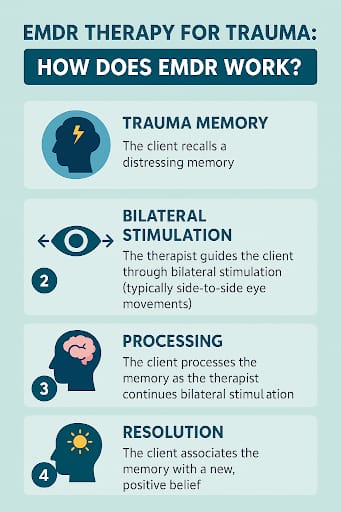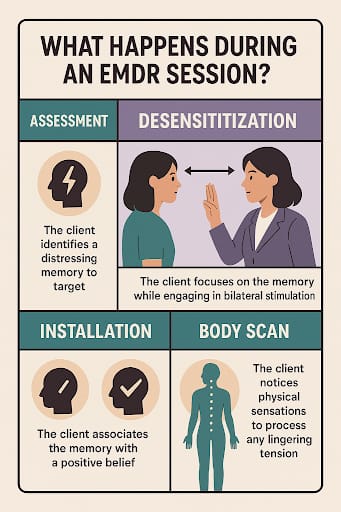
INTRODUCTION
Trauma can significantly affect one’s life, often creating emotional wounds that can be difficult to heal. In busy cities like New York many people experience trauma from accidents, abuse or unexpected loss. EMDR therapy (Eye Movement Desensitization and Reprocessing) is a novel treatment that allows individuals to process their traumatic memories and regain control of their emotional wellbeing.
In this blog, explaining the EMDR therapy process, who is a candidate for EMDR therapy, and what the process of healing looks like? Whether looking for yourself or a loved one, this blog is full of insight into trauma recovery specifically to EMDR.
What Is EMDR Therapy?
Eye Movement Desensitization and Reprocessing (EMDR) is a psychotherapy intervention created in 1987 by psychologist Dr. Francine Shapiro. EMDR was originally developed for the treatment of Post-Traumatic Stress Disorder (PTSD); however, many practitioners have utilized EMDR for various psychological conditions related to stressful memories.
The first clinical trial of EMDR was conducted in 1989, and many studies have proven its effectiveness, showing that EMDR often works more quickly than traditional forms of psychotherapy. EMDR is not talk therapy; instead, EMDR utilizes bilateral stimulation (often through guided eye movements) to assist the brain’s ability to reprocess memories of traumatic events.
Thereby desensitizing the emotional response, and ultimately allow the person to integrate the experience into their life in a more functional way.
Why Choose EMDR Therapy for Trauma?
EMDR therapy provides many unique advantages for trauma recovery, which makes it an increasingly popular modality for clinicians and patients in New York City.
- One of the key benefits is that EMDR is a non-invasive and drug-free intervention. EMDR relies on the natural healing processes of the brain, rather than medication, to mitigate trauma symptoms.
- Not only is EMDR considered safe, it has been found to be comparatively quick and effective, often with patients indicating significant improvement after fewer sessions than with traditional therapy.
- EMDR also does not require patients to tell the story of their trauma in detail, which is one of the reasons there is less emotional burden associated with EMDR compared to some other trauma-focused treatment modalities.
- By also directly targeting the unprocessed traumatic memories that are the cause of psychological distress, EMDR provides an avenue for lasting healing.
- Lastly, EMDR’s ability to be used with a range of issues further increases its clinical exchange, as EMDR can be used to treat PTSD, anxiety, phobias, depression, grief and even chronic pain.
How Does EMDR Therapy Work?
EMDR therapy takes a structured eight-phase approach that allows the brain to efficiently process and integrate the traumatic memories.
- Phase 1 is history and treatment planning. In this phase, the therapist will gather information about your trauma and current symptoms (e.g. flashbacks, panic, etc.) to determine some exact memories that the client would like to target to work on during the EMDR process.
- Phase 2 is preparation. In this phase, the therapist establishes a working relationship with the client, explains the phases of EMDR therapy, and teaches a few brain spotting strategies (e.g. mindfulness exercise, breathing techniques, etc.).
- In Phase 3, assessment, the therapist will work with the client with a specific traumatic memory to identify a few images associated with the memory, possible negative beliefs, any physical sensations they are experiencing, and a desired positive belief about themselves.
- Phase 4, desensitization, allows the client to use the bilateral and therapeutic stimulation, while still focused on the traumatic memory. This phase lowers the intensity of the memory and helps the brain process it therapeutically.
- In Phase 5, installation, this phase builds on the positive belief and will replace the negative belief.
- Phase 6, body scan, allows the client to assess their bodies for any residual sensations and to process them if necessary.
- In Phase 7 closure, the therapist helps to ensure that the client is emotionally stable and offers relaxation exercises to conclude the session.
- In Phase 8 reevaluation usually occurs at the start of the next session to gauge the work done, and to talk about the next steps in the treatment to help formulate a plan.
What Happens During an EMDR Session?

A standard EMDR therapy session in New York City can differ between 60 to 90 minutes in duration.
- A session usually starts with a short conversation to determine what memory is to be targeted in that session.
- Once a memory is chosen, the EMDR therapist will guide you to follow a bilateral stimulus while focusing on the target memory (typically the therapist’s finger moving back and forth with your eyes).
- As you are activating the memory, you may seem to be distracted by random spontaneously occurring images, emotions, or thoughts.
- This reflects the brain’s natural, spontaneous reprocessing abilities. The therapist will periodically pause to check in with you, look at your levels of distress, and make adjustments on the fly.
- It is normal to unexpectedly recall memory and emotions arise as you look at the target memory, and EMDR therapists are trained to handle these fluctuations and create a safe and supportive environment to process any reactions.
- After many sessions—each returning to the target memory events/ time—the emotional charge to the problematic memories will decrease, making room for a feeling of safety and adaptive thoughts/ feelings to replace the distressing ones.
Who Can Benefit from EMDR Therapy?
EMDR therapy has been successful in treating various trauma-based issues, making this a wonderful resource for many people.
- EMDR is often used for Post-Traumatic Stress Disorder (PTSD) in veterans, survivors of accidents, victims of assault, and also victims of childhood neglect or abuse, and survivors of medical trauma.
- EMDR has been beneficial for all forms of grief, anxiety disorders, phobias, trauma-related depression, and also individuals recovering from addiction.
- EMDR has also been helpful for performance anxiety in public speaking, sports, etc.
- EMDR is appropriate for adults, adolescents, and children, with approaches adapted to be developmentally appropriate, as was referenced by several trauma specialists in New York City.
Tips for Preparing for EMDR Therapy
When preparing for EMDR therapy, it’s very beneficial to be both mentally and emotionally prepared for the best outcomes possible.
- One important aspect is to be open and honest with your therapist and sharing your feelings, emotions, symptoms, and history fully and completely, will ensure the best care possible in whatever form you may be in treatment.
- Engaging in self care outside of the therapeutic sessions can help you stay present and control your emotional reactions.
- Self-care can include meditation, reading, traveling, exercising, working out, a hobby you enjoy, etc.
- Being realistic for your expectations as there is no timetable when it comes to healing from trauma.
- Healing is a process that happens at its own pace and some of it can surface over time. In your sessions, be sure to express any thoughts or feelings during the session that do not feel comfortable.
- Additionally, it is best to have the full support of family or trusted friends for encouragement on your journey of recovery.
Final Thought
EMDR therapy is a clinically-proven way to heal trauma and restore emotional wellness. It targets unprocessed memories and uses bilateral stimulation to allow the mind to naturally reprocess the experience without the emotional distress, reducing the emotional charge and allowing for adaptive thinking about the past.
- EMDR works for individuals suffering from PTSD, anxiety, grief, and performance anxiety.
- With the right therapist and safe place, many individuals have begun to heal and experience relief in New York City and elsewhere.
- Healing is a journey—and EMDR can be a healing journey for lasting peace and personal progress.
Reference
- Professional, C. C. M. (2025d, March 19). EMDR Therapy. Cleveland Clinic. https://my.clevelandclinic.org/health/treatments/22641-emdr-therapy
- WebMD Editorial Contributor. (2023, September 22). EMDR: Eye Movement Desensitization and Reprocessing. WebMD. https://www.webmd.com/mental-health/emdr-what-is-it
- Shapiro, F. The Role of Eye Movement Desensitization and Reprocessing (EMDR) Therapy in Medicine: Addressing the Psychological and Physical Symptoms Stemming from Adverse Life Experiences. The Permanente Journal, 18(1), 71. https://doi.org/10.7812/TPP/13-098
- EMDR International Association. (2024, January 8). Experiencing EMDR Therapy – EMDR International Association. https://www.emdria.org/about-emdr-therapy/experiencing-emdr-therapy/
- Post-traumatic stress disorder (PTSD) – Diagnosis and treatment – Mayo Clinic. (n.d.). https://www.mayoclinic.org/diseases-conditions/post-traumatic-stress-disorder/diagnosis-treatment/drc-20355973






